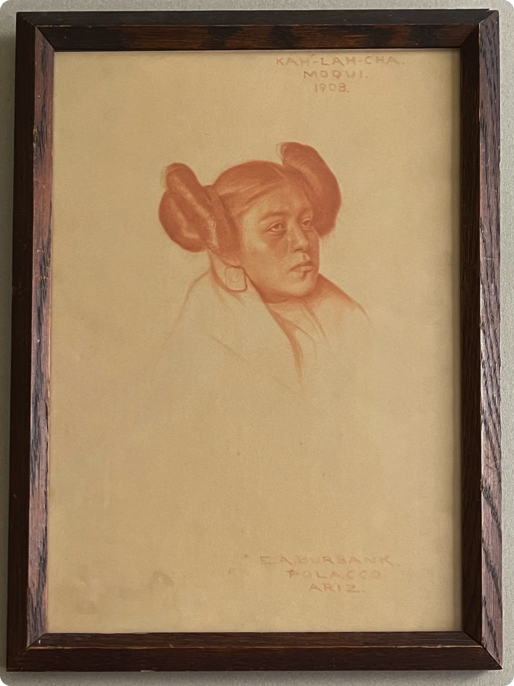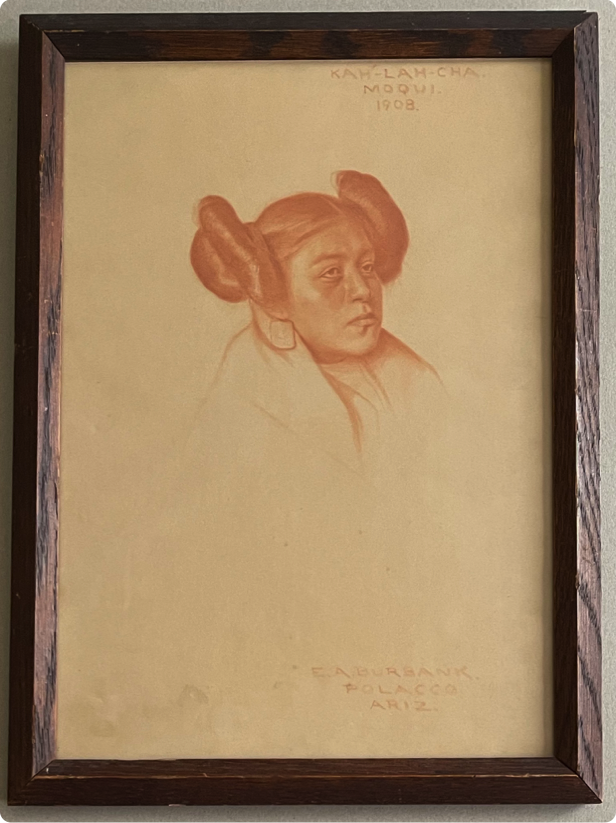
© 2010-2024 by Fine Arts of the Southwest, Inc. All rights reserved.
Unauthorized reproduction or use is strictly prohibited by law.
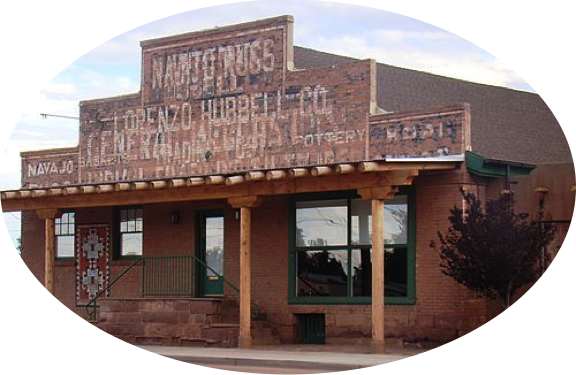
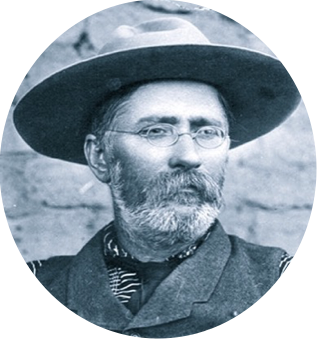
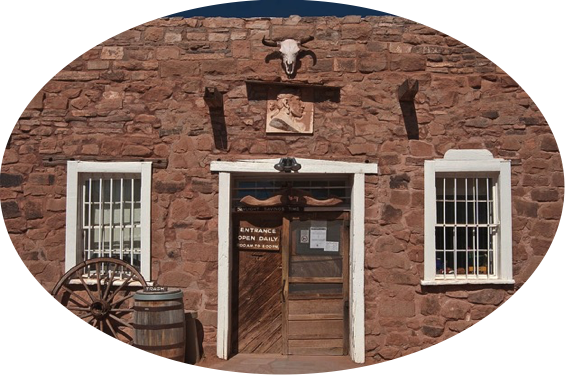
At left, front entrance of The Hubbell Trading Post in Ganado, Arizona, now a historic site of The National Park Service. At right, the old J.L. Hubbell Trading Post in Winslow, Arizona, now the site of The Winslow Visitor Center. These two locations are where this drawing has spent the past 116 or so years.
Left photo source and © by Witold Skrypczak. Right photo source and © Wikipedia
At left, Indian trader Juan Lorenzo (J.L.) Hubbell, c. 1910. At center, J.L. Hubbell inspecting a Navajo weaving at his trading post in Ganado, Arizona. At right, Elbridge Ayer Burbank, c. 1908.
Left and center photo source and © National Park Service. Right photo source and © Hubbell Trading Post National Site
A superb original red Conte crayon portrait
of “Kah Lah Cha, Moqui” a Hopi Indian maiden by Elbridge Ayer Burbank, Polacca, AZ, 1908
Ex: J.L. Hubbell Trading Post Collection, Ganado and Winslow, Arizona
One of the most fascinating and interesting personal stories of late 19th and early 20th Century Western American art is the story of the remarkable Harvard, Illinois-born artist, Elbridge Ayer Burbank (1858-1949) and the estimated 1200 or so Native American portraits he painted and drew over the course of his lifetime of all variety and manner of Native Americans from every day people like this young Hopi maiden, "Kah-Lah-Cha" to important luminaries such as Major Chiefs, Red Cloud, Geronimo, Manuelito, Joseph and many others. In fact, Burbank is reputed on very good authority to have been the only artist ever to have painted the fearsome Apache Chief Geronimo from life. These Burbank portraits collectively form one of the most comprehensive and accurate artistic, physical and anthropological portrayals, documentations and records of 19th and 20th Century Native Americans in existence.
One of E.A. Burbank’s favorite and most expressive artistic mediums throughout his career was classic French Conte crayon in black or red, the frequently used highly-expressive, difficult to use and unforgiving medium of the French Impressionists, as used in this outstanding portrait. Burbank’s numerous red Conte crayon portraits of Native Americans have in time become euphemistically known as his “Red Heads”. This wonderful portrait of a young Hopi indian maiden was painted in 1908 when Burbank was in residence at his Western studio in the small eastern Arizona settlement of Ganado, Arizona, courtesy of his great friend the prominent Indian Trader, Juan Lorenzo (J.L.) Hubbell (1853-1930) who did his friend Burbank the extraordinarily generous courtesy of providing him free studio space and residency at his famous Hubbell trading post in Ganado.
This portrait is most beautifully and most sensitively rendered in subtle shadings of red Conte crayon. The young
Hopi woman’s face, features, unique complex hairstyle and details of her distinctive rectangularly-shaped wood and turquoise mosaic earrings and wearing blanket are all very artistically portrayed in a very formal three-quarter profile academic style pose. Her expression is placid, timeless and somewhat inscrutable. The linework and shading here are nothing short of masterful. She looks young, vibrant and almost alive despite her being well over a century in age.
This portrait also has an absolutely perfect and wonderful provenance, it was acquired directly from the collection of the original historic J.L. Hubbell Trading Post outlet in Winslow, Arizona and it was purchased in the recent sale of a substantial portion of the post’s collection. Almost certainly J.L. Hubbell originally acquired this piece directly from his friend, Burbank as he did numerous other Burbank “Redhead” portraits of the nearby Hopi, Navajo and Apache Indians. Today, there is still a substantial collection of these Burbank ”Red Heads” on display in the National Park Service’s Historic Hubbell Trading post site in Ganado.
For more than a decade from 1897 on, Burbank used the Hubbell trading post as a sort of home base to range around the Southwest on his various painting excursions. Prominent Indian Trader, J.L. Hubbell was an enthusiastic friend and patron of a number of prominent Western artists, writers, intellectuals and anthropologists during this time period and his trading post became an epicenter and meeting ground of sorts for a variety of distinguished artistic luminaries from Burbank to W.R. Leigh to Maynard Dixon and many others. Burbank also importantly enjoyed the longtime patronage of his prominent Chicago Uncle, Edward Everett Ayer (1841-1927) who was the first President of the highly-influential Field Museum of Natural History in Chicago and who first employed his nephew to go west and paint and draw Indians both for the Field Museum's own collection and those of various other institutions and individuals.

The portrait measures 14 1/4" in height by 10" in width (sight size) and its framed dimensions are 16 1/4" by 12".
The work is very finely and appropriately framed in a period dark beveled wood frame. The drawing is beautifully titled and dated “Kah-Lah-Cha, Moqui, 1908” in the artist’s hand at the upper right and it is properly and equally attractively signed “E.A. Burbank, Polacca, Ariz.” at the lower right. “Moqui” is an older, now somewhat outdated word reference for Hopi Indian. The portrait is in outstanding original vintage condition and it has survived the past century and sixteen years in absolutely remarkable shape. We should all look nearly this good at age 116. Let’s talk about
a “Time Warp” here for a moment. The extraordinary original condition of the piece speaks directly to its unique and exceptional one-owner provenance. The drawing essentially moved only once in the past 116 years from the Hubbell Trading Post in Ganado, Arizona where it was created to The Hubbell Trading Post in Winslow, Arizona
180 miles away, where it was later sold.
We do not know much in detail about the particulars of precisely who the personal subject of this drawing, Kah-Lah-Cha is other than her Hopi name as recorded phonetically by Burbank and the fact that at the time of the portrait she was an unmarried Hopi woman or “maiden” as evidenced by her distinctive double-whorled Hopi maiden hairstyle.
This beautiful and mysterious Hopi woman’s compelling portrait is a wonderful and historically significant piece of the ancient history, life, culture and art of the Pueblo Southwest observed and immortalized for posterity by one its most most skilled, dedicated and important chroniclers.
SOLD

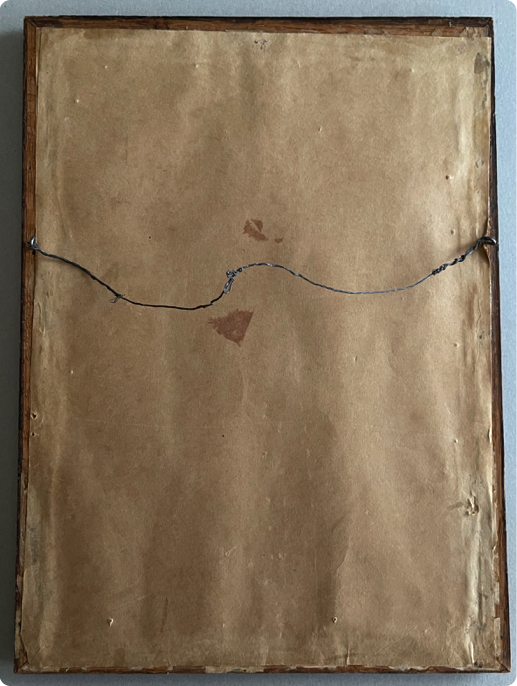

Could these be two different images of the same Hopi girl?
At right, "Hopi Maiden with Squash Blossom headdress, 1901" by A.C. Vroman.
Photo source and © "Photographer of the Southwest, A.C. Vroman", Ward Ritchie Press, 1961, pp. 80.
